There are many companies that provide 70-463 braindumps but those are not accurate and latest ones. Preparation with GreatExam 70-463 practice test study guide is a best way to pass this certification exam in easy way.
QUESTION 61
You are developing a SQL Server Integration Services (SSIS) package that imports data into a data warehouse hosted on SQL Azure.
The package uses a Foreach container to process text files found in a folder.
The package must be deployed to a single server by using the Project Deployment model. Multiple SQL Server Agent jobs call the package.
Each job is executed on a different schedule.
Each job passes a different folder path to the package.
You need to configure the package to accept the folder path from each job.
Which package configuration should you use?
A. Parent Package Variable
B. XML Configuration File
C. Environment Variable
D. .dtsConfig file
E. Registry Entry
Answer: C
QUESTION 62
Drag and Drop Question
You are developing a SQL Server Integration Services (SSIS) package.
The package uses custom functionality that accesses a SQL Server database.
The custom functionality must be implemented by using Language Integrated Query (LINQ).
You need to ensure that the LINQ code can be debugged at design time.
What should you select from the SSIS Toolbox? (To answer, drag the appropriate item to the correct location in the answer area.)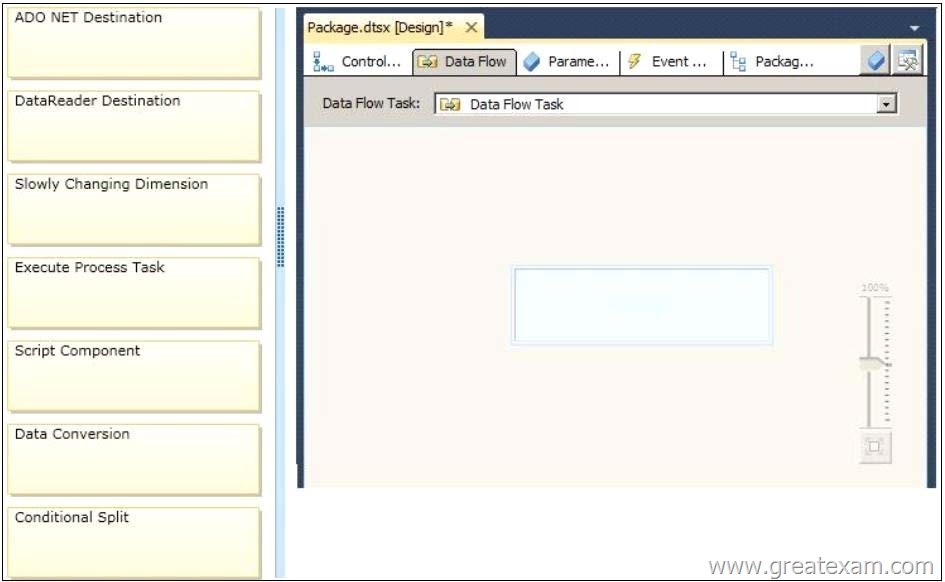
Answer: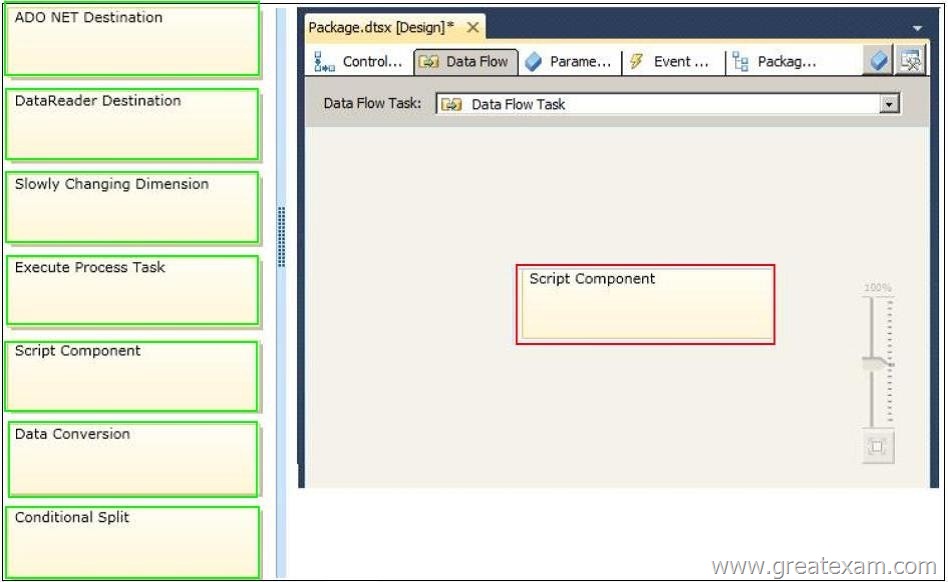
QUESTION 63
Drag and Drop Questions
You are developing a SQL Server Integration Services (SSIS) project by using the Project Deployment model.
The project contains many packages.
It is deployed on a server named SQLTest1.
The project will be deployed to several servers that run SQL Server 2012.
The project accepts one required parameter.
The data type of the parameter is a string.
A SQL Agent job is created that will call the Loading.dtsx package in the project.
A job step is created for the SSIS package.
The job must pass the value of an SSIS Environment Variable to the project parameter.
The value of the Environment Variable must be configured differently on each server that runs SQL Server.
The value of the Environment Variable must provide the server name to the project parameter.
You need to configure SSIS on the SQLTest1 server to pass the Environment Variable to the package.
Which four actions should you perform in sequence by using SQL Server Management Studio? (To answer, move the appropriate actions from the list of actions to the answer area and arrange them in the correct order.)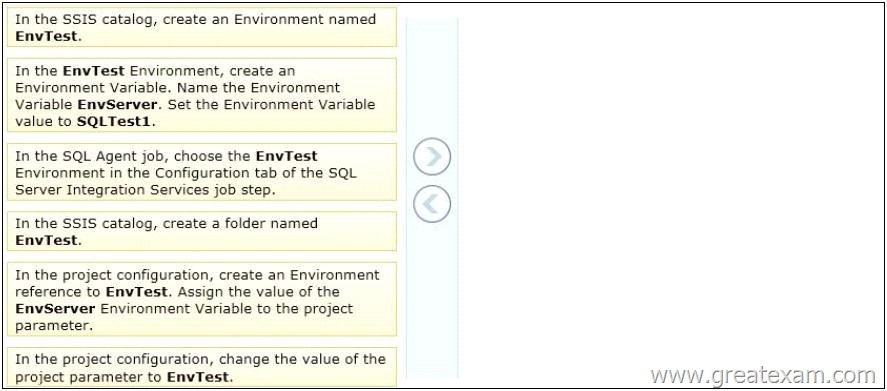
Answer: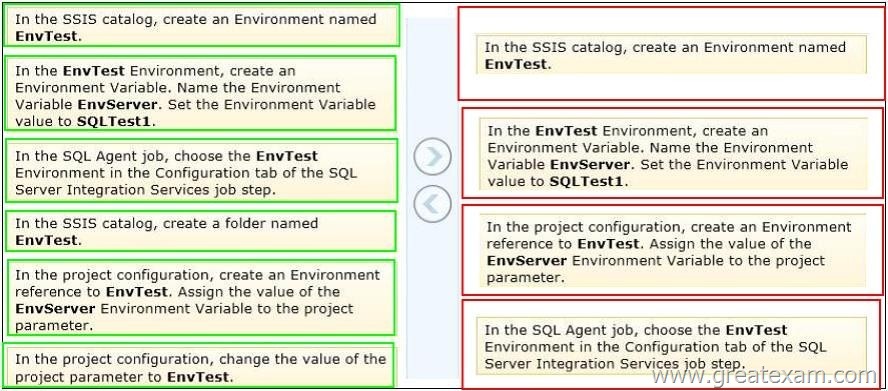
QUESTION 64
You are creating a SQL Server Integration Services (SSIS) package that implements a Type 3 Slowly Changing Dimension (SCD).
You need to add a task or component to the package that allows you to implement the SCD logic. What should you use?
A. a Data Conversion component
B. an Execute SQL task that executes a MERGE statement on the database
C. a Merge component
D. an Expression task
Answer: C
Explanation:
Note: Type of Slowly Changing Dimensions Slowly Changing Dimensions are categorized into three types named: Type 1, Type 2, and Type3.
The Type 1 SCD does not maintain the history of changing attributes, it overwrites values of the attributes.
Type 2 maintains historical values for changing attributes.
Type 3 that we do not use much maintains separate columns for changed attributes.
SSIS SCD wizard supports both Type 1 and Type 2.
Using MERGE instead of SCD wizard Replacement of SCD wizard with MERGE is not a straightforward technique.
If the SCD has both Type 1 and Type 2 types attributes, they need to be handled separately.
QUESTION 65
You are developing a SQL Server Integration Services (SSIS) package to load data into a SQL Server table on Server A .
The package includes a data flow and is executed on ServerB.
The destination table has its own identity column.
The destination data load has the following requirements:
– The identity values from the source table must be used.
– Default constraints on the destination table must be ignored.
– Batch size must be 100,000 rows.
You need to add a destination and configure it to meet the requirements.
Which destination should you use?
A. OLE DB Destination with Fast Load
B. SQL Server Destination
C. ADO NET Destination without Bulk Insert
D. ADO NET Destination with Bulk Insert
E. OLE DB Destination without Fast Load
Answer: A
Explanatione:
http://msdn.microsoft.com/en-us/library/ms141237.aspx
http://msdn.microsoft.com/en-us/library/ms139821.aspx
http://msdn.microsoft.com/en-us/library/ms141095.aspx
QUESTION 66
You are developing a SQL Server Integration Services (SSIS) package that imports data into a data warehouse.
You add an Execute SQL task to the control flow.
The task must execute a simple INSERT statement.
The task has the following requirements:
– The INSERT statement must use the value of a string package variable. – The variable name is StringVar.
– The Execute SQL task must use an OLE DB Connection Manager.
In the Parameter Mapping tab of the Execute SQL task, StringVar has been added as the only parameter.
You must configure the SQLStatement property of the Execute SQL task.
Which SQL statement should you use?
A. INSERT INTO dbo.Table (variablevalue) VALUES (@StringVar)
B. INSERT INTO dbo.Table (variablevalue) VALUES ($Project::StringVar)
C. INSERT INTO dbo.Table (variablevalue) VALUES (?)
D. INSERT INTO dbo.Table (variablevalue) VALUES ($Package::StringVar)
Answer: C
QUESTION 67
Drag and Drop Question
You are editing a SQL Server Integration Services (SSIS) package that uses checkpoints.
The package performs the following steps:
1. Download a sales transaction file by using FTP.
2. Truncate a staging table.
3. Load the contents of the file to the staging table.
4. Merge the data with another data source for loading to a data warehouse.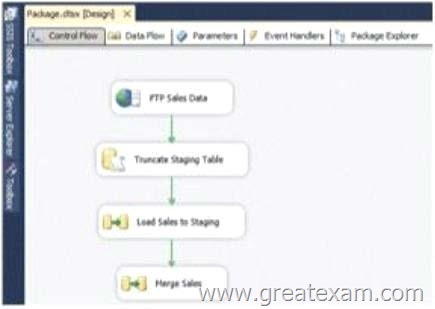
The checkpoints are currently working such that if any of the four steps fail, the package will restart from the failed step the next time it executes.
You need to modify the package to ensure that if either the Truncate Staging Table or the Load Sales to Staging task fails, the package will always restart from the Truncate Staging Table task the next time the package runs.
Which three steps should you perform in sequence? (To answer, move the appropriate actions from the list of actions to the answer area and arrange them in the correct order.)
Answer: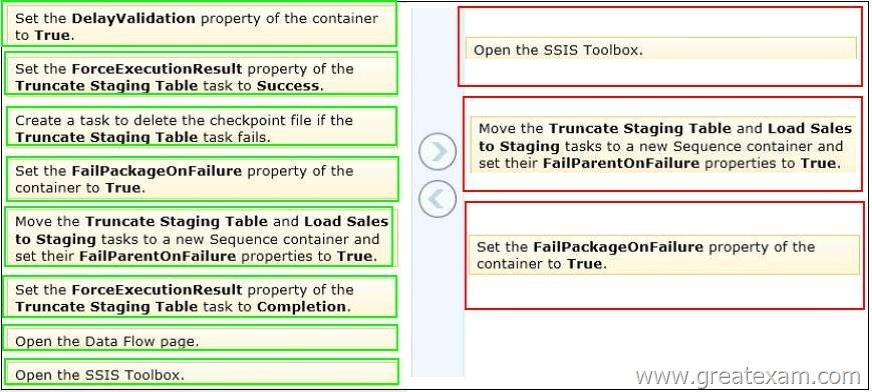
QUESTION 68
You are designing a SQL Server Integration Services (SS1S) package that uploads a file to a table named Orders in a SQL Azure database.
The company’s auditing policies have the following requirements:
– An entry must be written to a dedicated SQL Server log table named OrderLog.
– The entry must be written as soon as the file upload task completes.
You need to meet the company’s policy requirements.
Which event handler should you use?
A. OnProgress
B. Onlnformation
C. OnPostExecute
D. OnComplete
Answer: C
QUESTION 69
You are designing a package control flow.
The package moves sales order data from a SQL Azure transactional database to an on-premise reporting database.
The package will run several times a day, while new sales orders are being added to the transactional database.
The current design of the package control flow is shown in the answer area. (Click the Exhibit button.)
The Insert New Orders Data Flow task must meet the following requirements:
– Usage of the tempdb database should not be impacted.
– Concurrency should be maximized, while only reading committed transactions.
– If the task fails, only that task needs to be rolled back.
You need to configure the Insert New Orders Data Flow task to meet the requirements.
How should you configure the transaction properties? To answer, select the appropriate setting or settings in the answer area.
Answer:
IsolationLevel = ReadCommited
TransactionOption = Required
QUESTION 70
Drag and Drop Question
You are building a fact table in a data warehouse.
The table must have a columnstore index.
The table cannot be partitioned.
You need to design the fact table and load it with data.
Which three actions should you perform in sequence? (To answer, move the appropriate actions from the list of actions to the answer area and arrange them in the correct order.)
Answer:
QUESTION 71
Drag and Drop Questions
You are creating a sales data warehouse.
When a product exists in the product dimension, you update the product name.
When a product does not exist, you insert a new record.
In the current implementation, the DimProduct table must be scanned twice, once for the insert and again for the update.
As a result, inserts and updates to the DimProduct table take longer than expected.
You need to create a solution that uses a single command to perform an update and an insert. How should you use a MERGE T-SQL statement to accomplish this goal? (To answer, drag the appropriate answer choice from the list of options to the correct location or locations in the answer area. You may need to drag the split bar between panes or scroll to view content.)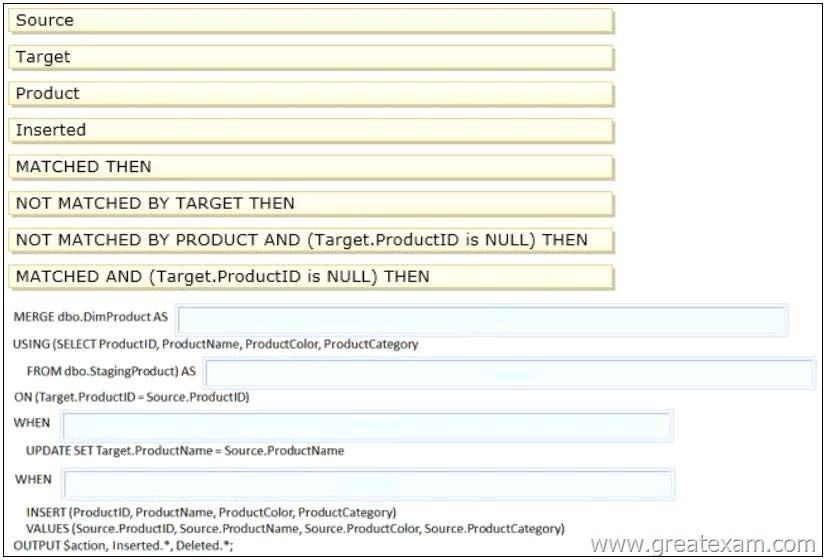
Answer:
QUESTION 72
You are designing a data warehouse for a fresh food distribution business that stores sates by individual product.
It stores sales targets by product category.
Products are classified into subcategories and categories.
Each product is included in only a single product subcategory, and each subcategory is included in only a single category.
The data warehouse will be a data source for an Analysis Services cube.
The data warehouse contains two fact tables:
– factSales, used to record daily sales by product
– factProductTarget, used to record the monthly sales targets by product category
Reports must be developed against the warehouse that reports product sales by product, category and subcategory, and product sales targets.
You need to design the product dimension.
The solution should use as few tables as possible while supporting all the requirements.
What should you do?
A. Create two product tables, dimProduct and dimProductCategory.
Connect factSales to dimProduct and factProductTarget to dimProductCategory with foreign key constraints.
Direct the cube developer to use key granularity attributes.
B. Create one product table, dimProduct, which contains product detail, category, and subcategory columns.
Connect factSales to dimProduct with a foreign key constraint.
Direct the cube developer to use a non-key granularity attribute for factProductTarget.
C. Create three product tables, dimProduct, dimProductCategory, and dimProductSubcategory, and a fourth bridge table that joins products to their appropriate category and subcategory table records with foreign key constraints.
Direct the cube developer to use key granularity attributes.
D. Create three product tables, dimProduct, dimProductCategory, and dimProductSubcategory.
Connect factSales to all three product tables and connect factProductTarget to dimProductCategory with foreign key constraints.
Direct the cube developer to use key granularity attributes.
Answer: B
QUESTION 73
You are reviewing the design of a student dimension table in an existing data warehouse hosted on SQL Azure.
The current dimension design does not allow the retention of historical changes to student attributes such as ParentOccupation.
You need to redesign the dimension to enable the full historical reporting of changes to multiple student attributes including ParentOccupation.
What should you do?
A. Add CurrentValue and PreviousValue columns to the student dimension.
B. Enable Snapshot Isolation on the data warehouse.
C. Add an IsCurrent column to the student dimension.
D. Add StartDate and EndDate columns to the student dimension.
Answer: D
Explanation:
Adding a start and end date will give you this ability as when a record is inserted and given a start and end date, you’ll have the ability to determine when they were active therefore giving you a retention of historical changes
QUESTION 74
You are designing an enterprise star schema that will consolidate data from three independent data marts.
One of the data marts is hosted on SQL Azure.
Most of the dimensions have the same structure and content.
However, the geography dimension is slightly different in each data mart.
You need to design a consolidated dimensional structure that will be easy to maintain while ensuring that all dimensional data from the three original solutions is represented.
What should you do?
A. Create a conformed dimension for the geography dimension.
B. Implement change tracking.
C. Create a degenerate dimension for the geography dimension.
D. Create a Type 2 slowly changing dimension for the geography dimension.
Answer: A
QUESTION 75
You are reviewing the design of an existing fact table named factSales, which is loaded incrementally from a SQL Azure database by a SQL Server Integration Services (SSIS) package each hour.
The fact table has approximately 4 billion rows and is dimensioned by product, sales date, and sales time of day.
The database administrator is concerned about the rapid growth of the database and users experience poor reporting performance against this database.
Reporting requirements have recently changed and the only remaining report that uses this fact table reports sales by product name, sale month, and sale year.
No other reports will be created against this table.
You need to reduce the report processing time and minimize the growth of the database.
What should you do?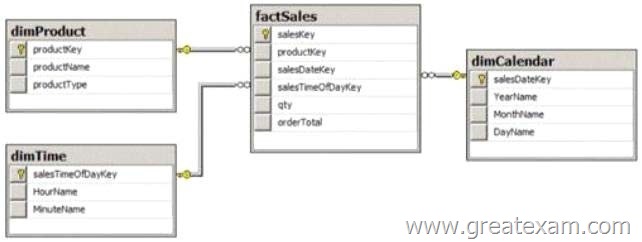
A. Create an indexed view over the fact table to sum orderTotal by month.
B. Create a view over the fact table to sum orderTotal by month.
C. Change the granularity of the fact table to month.
D. Partition the fact table by productKey.
Answer: C
QUESTION 76
You are adding a new capability to several dozen SQL Server Integration Services (SSIS) packages.
The new capability is not available as an SSIS task.
Each package must be extended with the same new capability.
You need to add the new capability to all the packages without copying the code between packages.
What should you do?
A. Use the Expression task.
B. Use the Script task.
C. Develop a custom task.
D. Use the Script component,
E. Develop a custom component.
Answer: C
Explanation:
http://msdn.microsoft.com/en-us/library/ms135965.aspx
http://msdn.microsoft.com/en-us/library/ms345161.aspx
QUESTION 77
You are creating a SQL Server Integration Services (SSIS) package to retrieve product data from two different sources.
One source is hosted in a SQL Azure database.
Each source contains products for different distributors. Products for each distributor source must be combined for insertion into a single product table destination.
You need to select the appropriate data flow transformation to meet this requirement.
Which transformation types should you use? (Each answer represents a complete solution. Choose all that apply.)
A. Slowly Changing Dimension
B. pivot
C. Lookup
D. Union All
E. Merge
Answer: DE
QUESTION 78
Drag and Drop Question
A SQL Server Integration Services (SSIS) project has been deployed to the SSIS catalog.
The project includes a project Connection Manager to connect to the data warehouse.
The SSIS catalog includes two Environments:
– Test
– Production
Each Environment defines a single Environment Variable named ConnectionString of type string. The value of each variable consists of the connection string to the test or production data warehouses.
You need to execute deployed packages by using either of the defined Environments.
Which three actions should you perform in sequence? (To answer, move the appropriate actions from the list of actions to the answer area and arrange them in the correct order.)
Answer: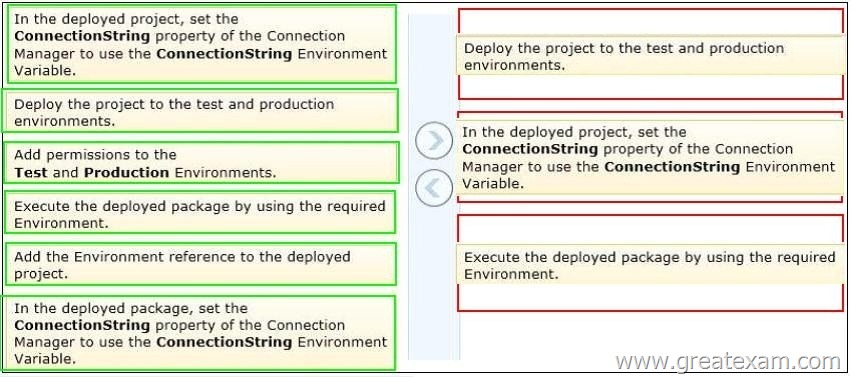
QUESTION 79
You are designing a SQL Server Integration Services (SSIS) data flow to load sales transactions from a source system into a data warehouse hosted on SQL Azure.
One of the columns in the data source is named ProductCode. Some of the data to be loaded will reference products that need special processing logic in the data flow.
You need to enable separate processing streams for a subset of rows based on the source product code.
Which data flow transformation should you use?
A. Audit
B. Source Assistant
C. Destination Assistant
D. Script Component
Answer: D
Explanation:
http://msdn.microsoft.com/en-us/library/ms137640.aspx
http://msdn.microsoft.com/en-us/library/ms141150.aspx
http://msdn.microsoft.com/en-us/library/ff929138.aspx
http://msdn.microsoft.com/en-us/library/ff929116.aspx
QUESTION 80
Drag and Drop Questions
You are developing a SQL Server Integration Services (SSIS) package that imports data into a data warehouse.
You are developing the part of the SSIS package that populates the ProjectDates dimension table.
The business key of the ProjectDates table is the ProjectName column.
The business user has given you the dimensional attribute behavior for each of the four columns in the ProjectDates table.
– ExpectedStartDate – New values should be tracked over time.
– ActualStartDate – New values should not be accepted.
– ExpectedEndDate – New values should replace existing values.
– ActualEndDate – New values should be tracked over time.
You use the SSIS Slowly Changing Dimension Transformation.
You must configure the Change Type value for each source column.
Which Change Type values should you select? (To answer, drag the appropriate value from the list of values to the correct location or locations in the answer area.)
Answer:
We give you the proper and complete training with free 70-463 GreatExam updates. Our braindumps will defiantly make you perfect to that level you can easily pass the exam in first attempt.